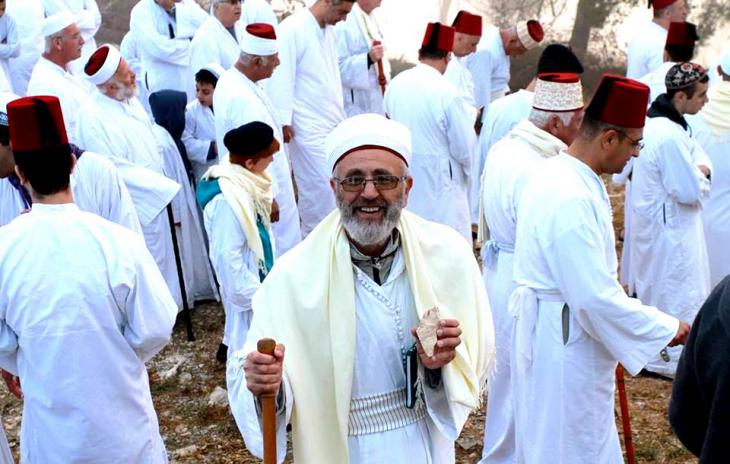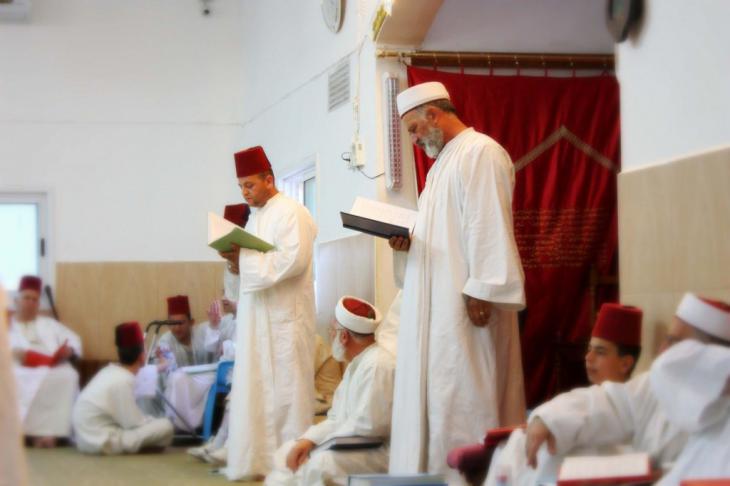The other "People of Israel"

The road winds steeply up Mount Gerizim. Down below, nestled in the dusty and hilly terrain, lies Nablus – a Palestinian city, a political hot spot in the Israeli-Palestinian conflict, and for millennia, a centre of human culture. The Bible refers to this place as Shechem, the land of the patriarch Jacob and his 12 sons, from which are descended the people of Israel. Some of their descendants still live on Gerizim.
Hosni Cohen is one of 12 Samaritan priests and the director of the small museum in Kiryat Luza, the Samaritan village. Here, dressed in traditional white garments and a red hat, he receives his guests.
Guardians of the Israelite faith
"The people of Israel were united when they came out of Egypt to the Holy Land, yet, around 1000 BC, the alliance collapsed. In the south, the tribes of Judah and Benjamin combined to form the Southern Kingdom of Judah with its capital city of Jerusalem. The remaining tribes formed the Northern Kingdom of Samaria with its capital in Shechem."
The Samaritans consider themselves to be the last descendants of this Northern Kingdom. For more than 3,000 years, they have lived in the direct vicinity of Mount Gerizim, which they venerate as a Holy Mountain and a place of God.
"We do not refer to ourselves as Samaritans, but rather as 'Shomroni,' the 'Guardians.' This is because we preserve the original commandments of our master, Moses," explains Hosni Cohen.

According to the Samaritans, the religion of the Israelites was altered by the Jews in exile. The Samaritan Torah consists exclusively of the five books of Moses and is written in Old Hebrew, a language that every member of the community learns from childhood. Although the religious community has several things in common with Judaism, such as observing the Shabbat and the practice of circumcision, the Samaritans prefer to stress the uniqueness and authenticity of their traditions, to which all members of the community are required to adhere.
The main reason for this lies in the constant concern about the survival of the community. Centuries of religious wars and forced conversions have practically decimated the community. In 1918, there were just 146 Samaritans. Today, the number is up to a little less than 800, in part due to the increase in marriages within the community to non-Samaritan women.
The dilemma of identity
Around half of all Samaritans live in Nablus, while the other half live in Holon near Tel Aviv, where a second community was formed in the 1970s as a result of better job prospects and a higher standard of living in Israel. The contact between the two communities is lively, with members travelling back and forth between the two cities – one could almost say between two worlds – buying their vegetables at the market in Nablus and travelling to Tel Aviv on their free days to relax on the beach.
The Samaritans in Nablus are not hindered by checkpoints or the security barrier, as they enjoy the unique privilege of holding both Israeli and Palestinian citizenship. Yasser Arafat paved the way for this initiative and remains a highly esteemed figure in Gerizim to this day.
Members of the Nablus community speak Arabic in their everyday lives and, in many respects, have adapted to their mainly Muslim Arab surroundings. By comparison, the Samaritans in Holon continue to move away from this aspect of their past, speak Hebrew, and maintain a lifestyle that is far less conservative than their brethren in Gerizim, where girls and boys are forbidden to go out with each other before marriage.

The Samaritans find themselves stuck in a dilemma concerning their identity. They are literally positioned between both sides of a conflict that is not only political, but also cultural. They claim to purposefully refrain from engaging in political affairs in order not to aggravate either side. "We feel bound to the Jews, as our religions are quite similar. Yet, at the same time, we feel bound to the Palestinians, since we live and work with them and our children attend their schools," explains Yaqub, who lives in Nablus.
This approach, however, does not always prove successful in avoiding conflicts. "Many Jews take us for Arabs, since we live in Nablus and speak Arabic, and they treat us accordingly," says Yaqub. "For example, I am always searched from head to foot at Ben Gurion Airport – just like the Palestinians." Similarly, the Palestinians, on occasion, view the Samaritans with distrust and even hostility.
Bridge of peace
Kiryat Luza is a neutral meeting place for all parties in the conflict, and "Café Paradise", which is also a supermarket, is its focal point. Israeli soldiers stock up on cola and cigarettes; Palestinians frequent the store because it is the only place in conservative Nablus that sells alcohol. Israeli and foreign tourists can be seen sipping cappuccinos and are pleased whenever a red-capped Samaritan comes into the store and completes the colourful picture.
The Samaritans like to see themselves as mediators, as a bridge between the Palestinians and the Israelis. Although they officially support a two-state solution with Jerusalem as a shared capital, they do not actively work to attain this goal. They have adapted to the situation as it stands.
Wasef, who works in "Café Paradise", sums up the position: "The conflict between the Israelis and Palestinians is part of our life. We don't like it, but we have become accustomed to it. And it doesn't affect us directly; we Samaritans live just as securely in Israel as in Palestine, and that is how things should remain."
Laura Overmeyer
© Qantara.de 2014
Translated from the German by John Bergeron